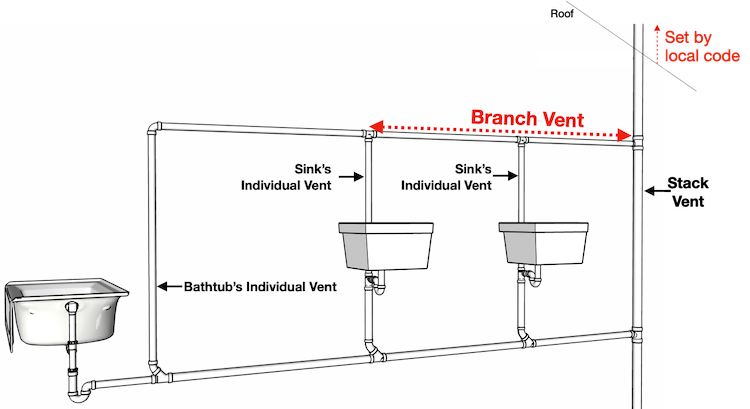The Way Adequate Ventilation Safeguards Your Plumbing System
The Way Adequate Ventilation Safeguards Your Plumbing System
Blog Article
Just about everyone will have their unique thinking involving The Upsides of Proper Ventilation in Plumbing Design.

Appropriate air flow in plumbing systems is frequently ignored, yet it is critical for maintaining the capability and security of your home's plumbing. Ventilation helps regulate atmospheric pressure, protect against the build-up of hazardous gases, and ensure the efficient elimination of waste. In this guide, we will certainly discover the importance of appropriate plumbing air flow, exactly how it works, and the advantages it brings to your plumbing system.
Recognizing Air Flow in Plumbing
Air flow in pipes describes the network of pipelines that allow air to stream via the drainage system. These vents offer multiple purposes, consisting of regulating air pressure within the pipelines, protecting against sewage system gases from getting in the home, and assisting in the smooth flow of wastewater.
Exactly How Ventilation Functions in Pipes Equipments
Air Pressure Policy
Proper air flow preserves well balanced atmospheric pressure within the pipes system. When water flows through pipes, it displaces air. Without adequate air flow, this variation can create unfavorable pressure, resulting in slow drains pipes or siphoning of water from catches, which can cause undesirable smells to leak into the home.
Preventing Sewer Gas Build-up
Among the most vital functions of plumbing vents is to prevent sewer gases, such as methane and hydrogen sulfide, from collecting within the home. These gases can pose major health threats and are very flammable. Vent pipes permit these gases to run away securely outside.
Assisting in Waste Removal
Air flow helps in the reliable elimination of wastewater by protecting against airlocks in the water drainage system. When air can move easily via the vents, it allows water and waste to stream efficiently through the pipes, minimizing the danger of obstructions and backups.
Kinds Of Plumbing Vents
Key Heap Vent
The major pile vent, likewise referred to as the vent stack, is the main vent in a pipes system. It expands from the primary drainpipe align through the roof, allowing gases to leave and fresh air to enter the system.
Branch Vent
Branch vents connect to the major pile vent and offer private components, such as sinks, bathrooms, and showers. These vents guarantee that each component has ample ventilation to function properly.
Air Admission Shutoff (AAV).
An Air Admittance Shutoff (AAV) is a one-way shutoff that permits air to get in the pipes system without the requirement for a conventional air vent pipeline extending through the roofing system. AAVs are typically used in remodellings or areas where installing a basic air vent is impractical.
Indicators of Poor Air Flow in Pipes.
Slow Draining Fixtures.
If your sinks, bathtubs, or commodes are draining pipes slowly, it could be a sign of poor ventilation. Poor air circulation can produce a vacuum cleaner impact, making it hard for water to drain correctly.
Gurgling Sounds.
Gurgling audios coming from drains are often an outcome of air being sucked through water traps because of unfavorable pressure in the pipelines. This is a clear indicator of inadequate ventilation.
Undesirable Smells.
Drain smells inside your home are a warning that your plumbing system is not properly ventilated. This can suggest that sewage system gases are not being effectively vented outside, leading to possibly dangerous conditions.
Usual Air Flow Mistakes.
Inadequate Vent Sizing.
Utilizing undersized vent pipes can lead to poor air circulation and pressure imbalances in the system. It's essential to use vents that satisfy the details demands of your pipes system.
Improper Vent Positioning.
Positioning vents too far from the components they offer can minimize their performance. Appropriate positioning ensures that air can move freely and successfully with the system.
Ignoring Code Requirements.
Building ordinance supply certain standards for pipes ventilation. Neglecting these codes can result in a system that stops working to operate correctly and may cause costly repair work or carcinogen.
Benefits of Appropriate Air Flow.
Enhanced System Efficiency.
Appropriately ventilated plumbing systems operate extra effectively, with fewer obstructions, faster draining pipes, and much less pressure on the pipes. This performance prolongs the life expectancy of the pipes system.
Improved Air Quality.
By avoiding drain gases from entering your home, appropriate air flow contributes to better indoor air high quality, making your living setting healthier and more comfortable.
Avoiding Water Damages.
Adequate ventilation aids protect against water from being siphoned out of catches, which can lead to sewer gases getting in the home and creating water damages in time.
Steps to Ensure Proper Air Flow.
Consulting Pipes Codes.
Constantly speak with regional plumbing codes when designing or changing your plumbing system. These codes supply the needed standards for correct airing vent and guarantee your system fulfills security requirements.
Normal Inspection and Upkeep.
Regular examinations can assist recognize potential air flow concerns before they become major problems. Maintenance tasks, such as cleaning vent pipelines and checking for clogs, are important for maintaining the system in good working order.
Professional Installment.
For new setups or major alterations, it's a good idea to employ an expert plumbing. They have the expertise to make certain the ventilation system is properly created and mounted according to code.
Final thought.
Correct air flow is an essential part of any kind of pipes system, guaranteeing that it works effectively and securely. By understanding the relevance of air flow, identifying the signs of poor ventilation, and taking actions to keep your system, you can avoid expensive problems and secure your home's air high quality.
4 Things You Should Know About Your Plumbing Vents
What Plumbing Vents Are
Also called a vent stack, a plumbing vent is a vertical pipe attached to your drain line that runs through your roof. The plumbing vent pipe, or plumbing air vent, removes gas and odors from your plumbing system and allows fresh air to enter the pipes, helping the water to flow out of the drain pipes.
What Plumbing Vents Do
Plumbing vents have two basic functions. One of which is to allow unpleasant smelling wastewater and sewer gasses to escape your plumbing system instead of entering your home. Plumbing vent pipes are typically located on roofs, away from windows, to ensure the fumes exit the home completely.
The other function of the plumbing vent is to move fresh air into your plumbing system. This helps move water through every plumbing fixture in your house, like toilets and sink drains. Think of the way in which you need to let a little air into the bottle as you pour soda in order to make the drink flow smoothly.
Different Types of Plumbing Vents
True vent: This is the most common vent option. In simplest terms, a true vent is a vertical pipe attached to your drain line that exits through the roof. They often function as the main vent that other fixtures can connect to. Re-vent pipe or auxiliary vent: Attached to the drain line near specific plumbing fixtures, re-vent pipes run up and over to connect to the main vent. Common vent: Two plumbing fixtures installed on opposite sides of a wall are typically tied into the vent stack using something known as a sanitary cross. Wet vent: This venting option operates as a drain pipe and a vent at the same time. Wet vent drainage systems drain water from one fixture while venting the air from another. Although they’ve been used for over 100 years, wet vent systems have only recently been added to the plumbing code in many areas. If you’re planning on installing one in a bathroom remodel, make sure you check your local code prior to construction. Loop vent: For free-standing fixtures like kitchen island sinks, loop vents are ideal. These vent pipes run under the floor, rise from the P-trap, and create a loop inside the cabinet sink. Air admittance valve: An AAV is a one-way mechanical valve typically installed at the site of the plumbing fixture. AAVs allow venting to occur without having to tie into a larger venting system. They’re ideal for venting fixtures where you aren’t able to easily connect to an existing vent system. Common Plumbing Vent Issues
Although vent pipes typically don’t have water flowing through them, they’re still subject to many typical plumbing issues. For example, clogs are one of the most common problems associated with sewer vent pipes. If your vent pipe gets clogged, all of your plumbing fixtures tied into the vent stack will be affected.
A sink with a slow drain that bubbles and gurgles or a strong sewage smell around your toilet are both indicators that your toilet vent pipe is clogged. Because most vent pipes exit through the roof, old leaves, twigs or even a bird’s nest could be clogging the pipe.
Clogs in your vent pipe system cause a buildup of negative pressure, meaning that water won’t be able to flow out of your home very well. It’s similar to putting your finger over the opening of a straw to trap water inside. When you remove your finger, the water is able to flow out of the straw.
If you suspect you have any blockage in your vent, make sure you have a professional come examine the situation. Left unchecked, a blocked air vent can lead to other costly repairs, like leaks and sediment buildup.
Under Pressure
Pipe vents are essential aspects of a home’s plumbing system. Owning a home means learning about all sorts of things you never put much thought into before. But by understanding as much as you can about the important systems of your home, you can keep those budgets intact and those anxiety levels low.
https://www.homeserve.com/en-us/blog/home-improvement/plumbing-vents/

We were shown that report on What Is a Plumbing Vent and Why Is It Important through an associate on our other site. You should take a moment to distribute this article if you appreciated it. Kudos for being here. Revisit us soon.
Click Here Report this page